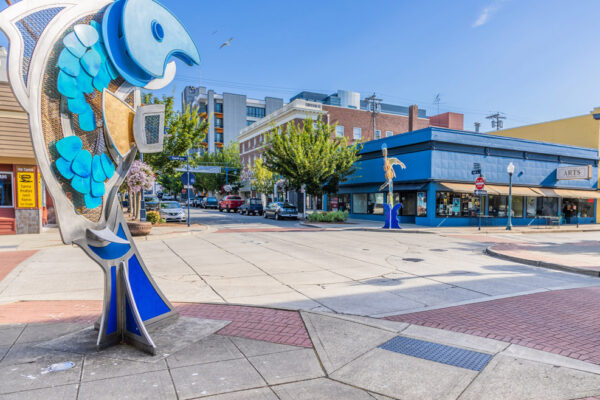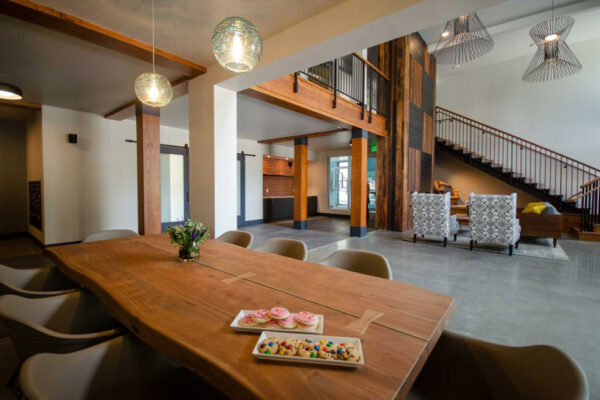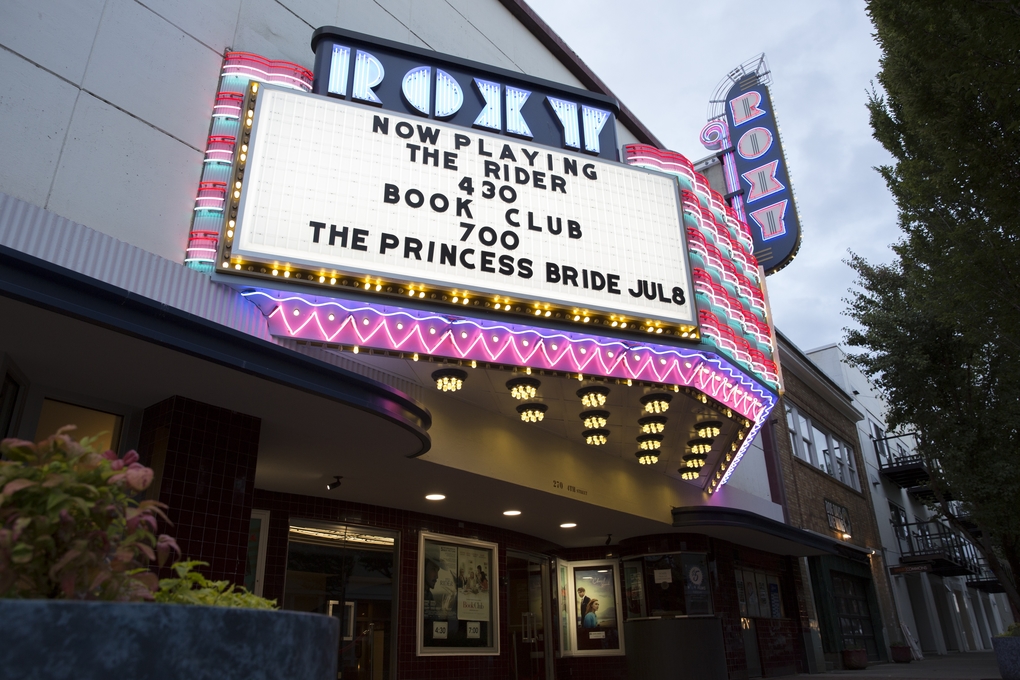The Roxy, revitalized: A vintage Bremerton moviehouse comes back to life

Buildings, like movies, have stories to tell. Bremerton’s Roxy Theatre, watching a changing world go by from its quiet downtown setting, a mere popcorn toss from the ferry terminal, has an unusually long one; from riches to rags to (fingers crossed) riches again. Earlier this spring, after many years of quiet, the Roxy came back to life. It’s been a very long intermission, but the movies have finally returned.
Generations of Bremertonians grew up enjoying a night out, along with lemon-custard ice cream (a theater trademark; you could buy it out on the sidewalk), at the Roxy, which opened its doors in May 1941 with the Jean Arthur comedy “The Devil and Miss Jones.” Newsreel footage shows its first night as a gala occasion; happy moviegoers in suits and hats swarm outside the theater, as a narrator pronounces that the sparkling-new theater would be “a distinctive addition to the city’s growing civic center.” The Roxy, its art-deco curves designed by Bjarne H. Moe (architect of a number of theaters in the Pacific Northwest, including the University District’s Varsity Theater), was “simply marvelous,” pronounced the mayor, while a little girl shyly described the theater as “awful nice.”
For decades, the best place to see a movie in the area was from one of the Roxy’s red-velvet seats; a place where uniformed ushers with flashlights would show you to your seats, and a vast 1908 photomural by Asahel Curtis — Edward Curtis’ brother — of the Bremerton Navy Yards graced the oval-shaped concessions area (which was originally, according to current general manager Michael Goodnow, a smoker’s lounge). Bing Crosby once performed there; so, legend has it, did Frank Sinatra. Longtime theater manager Clarence “Cabbie” Baur — hired shortly after the Roxy’s opening, he ran it for 40 years — kept the place shipshape.But the Roxy’s story, along with the stories of so many early-to-mid-century moviehouses, took a turn in the ’80s. Retail began moving away from the downtown waterfront and into suburban malls. Fewer people came, the lights slowly faded and the theater closed its doors in 1988.
And then it sat “mostly empty for 30 years,” said Goodnow, who’s also a Bremerton City Council member and the president of the Downtown Bremerton Association. Calvary Chapel of Bremerton bought the building in 1999 and used it for church services, before falling into foreclosure in 2012. Then Wes Larson and Mike Brown, of Sound West Group in Bremerton, came along. The real-estate developers, intent on revitalizing the downtown district, had bought the old Sears department store down the street from the Roxy, as well as the former Ford dealership.
“We had no intention at that point of owning a theater,” said Larson, who grew up in Bremerton and remembered seeing “Star Wars” at the Roxy long ago. “But we thought that, given its location, we couldn’t bear to see it just continue to be vacant and a blight. We didn’t want to see it opened as anything else — we didn’t want it to become a church again or a bar, which were some of the other rumored uses. So we bought it, literally, on a whim.”
The nonprofit entity Roxy Bremerton was created, to maintain the theater, fundraise for it and to make it available for live community events. On the movie side, the local company Far Away Entertainment (which operates nine other theaters in Western Washington, including the Varsity and West Seattle’s historic Admiral) signed on to operate the theater, which reopened for business in March. Jeff Brein, Far Away’s managing partner, says they’re planning mostly arthouse fare (so as not to compete against nearby multiplex SeeFilm), as well as some special events.
“We’re early enough in this process,” he says, “that we’re going to try everything we can try. We’re going to see what works and see what doesn’t work.” Already, the Roxy has launched a monthly series of “cult classic block parties,” in which the theater partners with a nearby brewery and food vendors for an outdoor party before the show. (Titles so far have included “The Big Lebowski” and “The Princess Bride.”) Classic foreign films are planned as well, possibly in conjunction with a First Friday Art Walk.
Restorations for the theater focused on its history; on keeping it, as much as possible, like that shiny 1940s moviehouse it once was. There was, said Brein, some brief discussion of transforming the theater from a single screen to a two-plex, “but collectively we all agreed, we probably would have pretty well cratered the aesthetic value of the theater and the historical significance of it.” The theater seats and carpet were still in good shape, as were the wood and tile floors in the lobby (the latter of which features, appropriately for this Navy town, a compass).
Fernando Duarte Design, a California company that specializes in vintage theater restoration, assisted with re-creation of the theater’s dancing-neon marquee (the original was too badly damaged), and its “blade,” the Roxy sign perched high on the building. The photo mural was meticulously cleaned — it had, over the years, become coated with popcorn oil — and given a protective cover. And the lobby’s distinctive multipetaled chandelier was carefully reconstructed; some of its parts, Larson said, were found for sale on eBay, disassembled.
Not everything at the Roxy is vintage: The projection booth — where you can see the footprints, worn into the floor, of a long-ago projectionist — now houses a brand-new laser projector, and Dolby sound has been installed. The electrical system was updated, and an ADA-compliant bathroom is now accessible from the upper lobby (the original bathrooms remain, each below a staircase on either side of the concession stand).
But if you wander the interior, you’ll see plenty of echoes from the past. Across from the ladies’ room is a closed door; inside are the original wooden lockers for the theater ushers, who would change into a uniform before beginning a shift. The old hexagon-shaped ticket booth is still there, though not currently in use, as is the former coat-check and phone-booth area. The lobby’s curving walls (which extend even into the nonpublic areas of the theater, such as the manager’s office) seem to reach out in welcome; the lovingly framed old posters out front trumpet the Roxy’s “Great entertainment,” “courtesy,” “service” and “comfort.”
When you settle into a Roxy seat, it squeaks, just the littlest bit; it has that feeling of being full of stories. This one, like so many of the movies shown here over the years, just might be headed for a happy ending.





